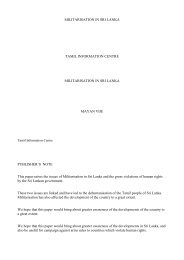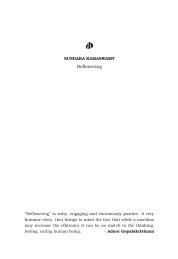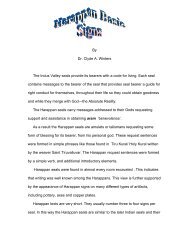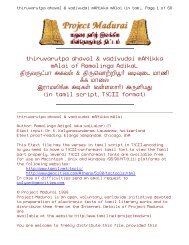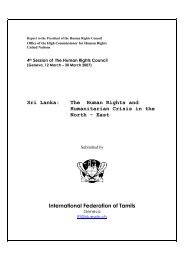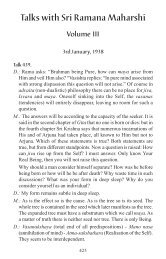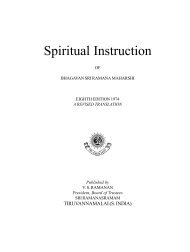Conflict in Sri Lanka: Ground Realities - Tamil Nation & Beyond
Conflict in Sri Lanka: Ground Realities - Tamil Nation & Beyond
Conflict in Sri Lanka: Ground Realities - Tamil Nation & Beyond
- No tags were found...
You also want an ePaper? Increase the reach of your titles
YUMPU automatically turns print PDFs into web optimized ePapers that Google loves.
east because the Muslims reacted to the clashes by demand<strong>in</strong>gthe government give them protection, which served to legitimisethe state <strong>in</strong> the eyes of that community. Such counter<strong>in</strong>surgencyoperations are undertaken by the state backed by <strong>in</strong>tensemedia propaganda that questions the LTTE’s legitimacy, and itsadherence to human rights and good governance norms <strong>in</strong> thenortheast – especially <strong>in</strong> relation to the Muslims.The Use of NGOsThe only place where the state’s counter<strong>in</strong>surgency worksm<strong>in</strong>imally is <strong>in</strong> the LTTE-controlled areas. But it has to be notedthat counter<strong>in</strong>surgency operations use NGOs – some of whichare <strong>in</strong>volved <strong>in</strong> promot<strong>in</strong>g women’s rights, children’s rights,environmental issues, humanitarian concerns – not for the wellbe<strong>in</strong>g of the civilian population but to spark off conflict betweenthe civilians and the rebel leadership by promot<strong>in</strong>g different andcompet<strong>in</strong>g social and political norms. This is not say that allNGOs and civil society organisations fall <strong>in</strong>to this category, butthose – and there are plenty of them around – that are createdexplicitly for the purposes of counter<strong>in</strong>surgency.The use of the CFAWhile the government uses the strategy of procrast<strong>in</strong>ation to tireout <strong>Tamil</strong> civilians and thereby deactivate the environment <strong>in</strong>which political demands are made, it has to also neutralise theLTTE. This was done by forc<strong>in</strong>g the rebels to enter <strong>in</strong>to protractednegotiations. The basis for the negotiations was the CFA. Butwhat is usually glossed over <strong>in</strong> articles and discussions with<strong>in</strong>the public doma<strong>in</strong> is that the CFA was and is grossly unfair bythe LTTE. This was accomplished by the government of <strong>Sri</strong> <strong>Lanka</strong>be<strong>in</strong>g assigned the role of safeguard<strong>in</strong>g the country’s sovereigntyand territorial <strong>in</strong>tegrity. (“The <strong>Sri</strong> <strong>Lanka</strong>n armed forces shallcont<strong>in</strong>ue to perform their legitimate task of safeguard<strong>in</strong>g thesovereignty and territorial <strong>in</strong>tegrity of <strong>Sri</strong> <strong>Lanka</strong> without engag<strong>in</strong>g<strong>in</strong> offensive operations aga<strong>in</strong>st the LTTE.”) In other words, the CFAthat became practically operable only through the military paritybetween the two protagonists to the conflict is systematicallyunderm<strong>in</strong>ed because the LTTE cannot be legitimately re-supplied17



